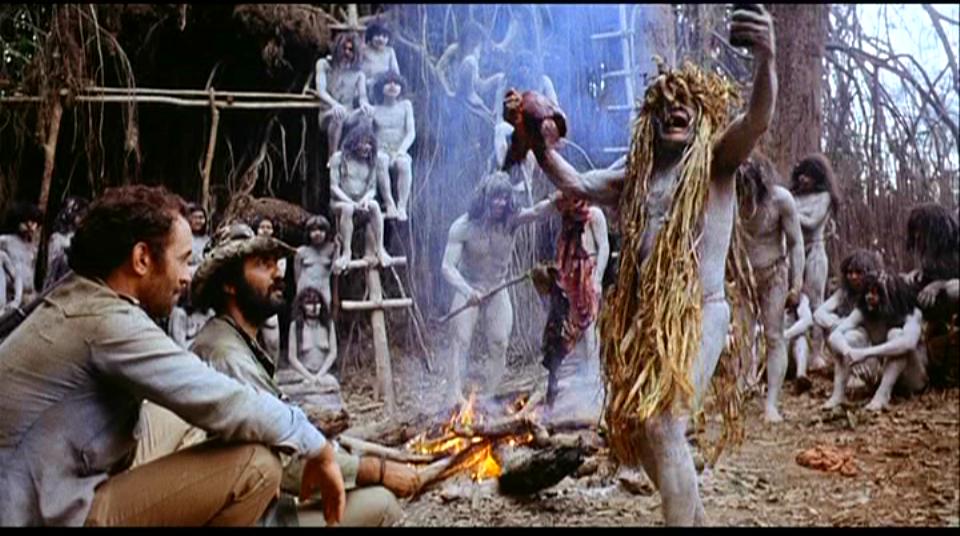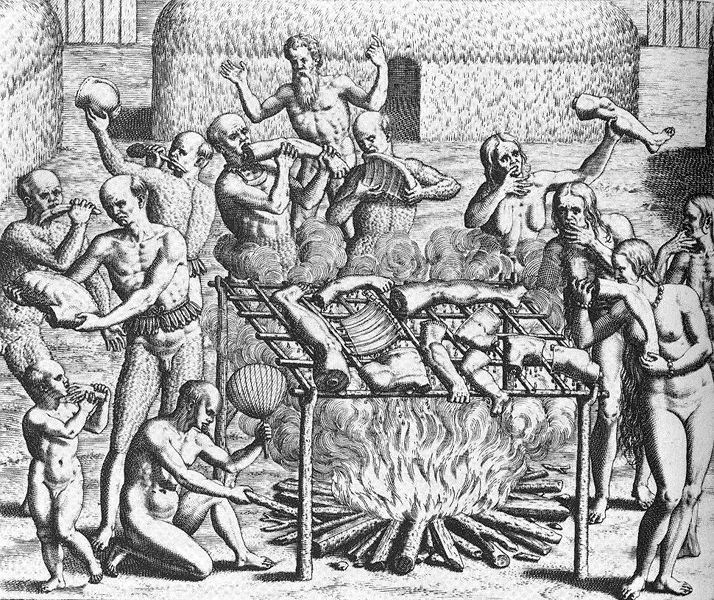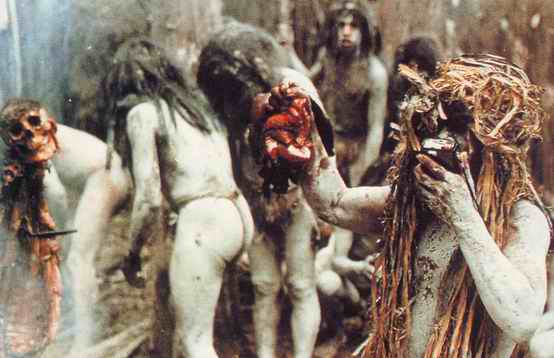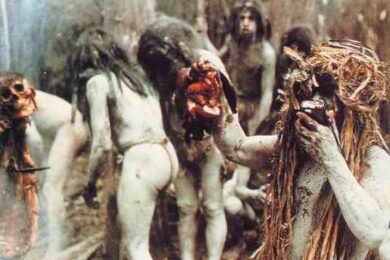So our exasperated sigh of disgust has been sucked gratefully back into our lungs at the news that the upcoming Cannibals is not to be a remake after all but a companion piece to _Cannibal Holocaust_ directed by none other than Ruggero Deodato himself. Happy days!
Cannibals are ace and, more to the point, they remain a largely untapped oasis for the creative desert in which modern horror films have come to exist. Unless, of course, we look at the specific case of The Blair Witch Project.
Frank Herbert once wrote in the preface to a book of his short stories of 46 points of comparison between his Dune books and Star Wars. Similar efforts have been made to identify the connections between Blair Witch and Deodato’s notorious and controversial shocker and the salient points are too numerous to talk about here. Flesh eating has been a feature on cinema screens for years and generally back in fashion in recently thanks to the zombie resurgence. But the astute makers of BWP saw something else going on in Cannibal Holocaust and, since that film went stratospheric and made bundles of cash, other filmmakers have jumped on board too. Witness the huge profits (and tepid dreariness) of Diary of the Dead and Cloverfield for more details, and then when you can summon the will to live check out REC (avoid US remake Quarantine), Brian De Palma’s Redacted and District 9 for the true spiritual successors to Deodato’s masterpiece. We know what you’re thinking. At what point, and under the influence of what drug, does Cannibal Holocaust become influential masterpiece and the key driver behind challenging and confrontationally brilliant works of over thirty years hence?

When we think of cannibals in cinema the prerequisite flesh-eating appeal is only a small part of the equation. After all the zombies had been at it for some time courtesy of Romero, Italian schlockmeister Lucio Fulci and a whole slew of lesser impersonators. In fact even bandwagon favourites such as Cannibal Apocalypse and early Cronenberg flick Rabid (in which infection leads to victims becoming murderous flesh eaters) were essentially zombie films in disguise and, as such, did as much to inform the shamelessly derivative content of 28 Days Later as any of Romero’s work. There was something else at work in the truly iconic heavyweight cannibal vehicles. The flesh eating taboo is softened somewhat when we dehumanise the transgressor. As Professor Logan pointedly remarks in Day of the Dead cannibalism implies an inter-species activity. To be truly terrifying cannibalism must be conducted in a fashion that is, from the perspective of the antagonist, mundane and enjoyable. To them it must be a way of life as run-of-the-mill as stuffing a chicken or having one off the wrist watching Aerobics Oz Style. [Christ give me strength, Ed] In cinema this has been generally handled in just a handful of ways. The disfunctional family a la Texas Chainsaw Massacre, the weird underworld mutant cult as in the stylish but hollow French horror Frontiers, or the terrifying and damaged loner in the hilariously gratifying Ravenous or the disappointingly pretentious Grimm Love. The most instantly recognisable and satisfying way however, as evidenced by the slew of cannibal nasties courtesy of Italian and Spanish cinema, is the primitive man-eating tribes in the darkest (civilisation-wise) recesses of the globe who cannot be reasoned with because not only is the behaviour culturally ingrained but we don’t speak a word of the lingo. A place where being an educated western anthropologist simply carries no weight with the turtle-flaying, larvae munching locals. It is this latter hostile environment that places our protagonists in the greatest danger. When chased by Leatherface you’re never really too far from a main road but when being borne down upon by yelling tribesmen in the jungles of Borneo you’re in a much deeper pile of shit.
The real appeal to jaded sensation hungry audiences of the most notorious cannibal shocker and daddy of them all, Ruggero Deodato’s notorious Cannibal Holocaust, is twofold. First the cannibals revel in their antisocial habits and are giddy, mostly naked little fellas whose tiny cocks may well terrifyingly brush your arm slightly as they hack your nuts off with poorly fashioned weapons. Second, and perhaps the most uniquely tappable point from the perspective of the modern filmmaker, the Mondo documentary style lends the proceedings an uncomfortably low tech, lo-fi quality resulting in an experience that requires much less suspension of disbelief than the slick Panavision horror style that was being simultaneously pioneered by John Carpenter at the other end of the horror spectrum. This is the point at which Cannibal Holocaust turned genre film-making on its head. Deodato invited us to partake of a filmic experience through the willing suspension of disbelief upon which all films rely but in this case with a twist. He invited us to accept the displaced context of the documentary within the movie and go along on a ride that felt, and still feels uber-real. When this documentary style is coupled with a combination of scenes containing shocking and real examples of animal cruelty and the seamlessly integrated gore effects courtesy of luminaries such as Aldo Gasparri the result is simultaneously revolting and utterly hypnotic. It is no small feat that almost 30 years after its creation it is still a deeply affecting visual experience that remains, in its uncut form, banned in a number of countries including our own.
Best of all it is utterly terrifying.
The runaway grindhouse success of Holocaust sparked a mini-revival in a genre that had sputtered alongside zombie flicks since the early seventies and was quickly followed up by industry stalwart Umberto Lenzi.
Lenzi was a moderately talented spaghetti-war film specialist responsible for a raft of exploitation titles covering diverse subjects from Robin Hood to pirates and more traditional Italian crime caper fare. He had already dipped his toes into cannibalism and could be described as the man who started it all in 1972 with Il Paese del Sesso Selviaggo or, as it is more widely known, The Man From Deep River. Ironically Ruggero Deodato’s first effective entry into the genre Ultimo Mondo Cannibale originated as a sequel to Deep River and Deodato replace Lenzi as director just before shooting commenced. It would be eight years before Lenzi entered that territory again with the disappointing Mangiati Vivi! Also known as Eaten Alive it was a clumsy and uninspired film that borrowed scenes liberally (and quite literally, as in cut and pasted) from other equally unspectacular titles such as the Ursula Andress vehicle Mountain of the Cannibal God, a film notable only for Stacey Keach’s for once unconcealed hair lip and an obligatory and excruciating scene of genital mutilation.

Lenzi followed this with one of the more intriguing entries into zombie territory Nightmare City in which the zombies/pseudo zombies (we never truly discover which) use guns, drive cars and are an all round more rapacious bunch of breast tearing rapscallions than their shambling brethren. His most memorable entry into the field however would be the awesomely titled Cannibal Ferox AKA Make Them Die Slowly. Condemned by many critics as an uninspired and copyist Holocaust clone it proudly stands alone as a genuinely disturbing and highly effective entry into the field which ticks all of the right boxes including ‘civilised’ westerners out of their depth, genital mutilation, impalements, animal cruelty and, cementing its place in movie history, the infamous and eye wateringly disgusting meat hook scene. Both Holocaust and Ferox benefit from being skilfully shot and edited by men who cut their teeth making tiny budgets and meagre resources stretch a long way. In most of their films these impediments were insurmountable but in the low tech world of jungles, cannibals and extraordinary cruelty they ironically became an asset. It is fitting that Lenzi, the man who began the grindhouse cannibal craze, effectively ended it with such a brutal and bowel pounding shocker. But ultimately it failed to accomplish or even mimic the achievements of its immediate predecessor.
As I said before, Blair Witch is widely touted by critics as the film that regenerated the public interest in horror films and redefined a genre. Knackers! Cannibal Holocaust redefined what is possible within the narrative constraints of not only the horror genre, but cinema itself. Cannibal Holocaust is the true progenitor of a slew of modern films that decry aspects of ourselves and our own dark nature whilst simultaneously entertaining, thrilling and informing us from the safety of our cinemas and living rooms.
We have seen from the recent resurgence of the zombie that an inspiration starved industry is prepared to turn to pretty much anything in order to make a few quid and, occasionally, this may result in some great material making it onto our screens.
Hollywood even briefly reignited the pirate movie craze for all of about three weeks, with limited success. Following the first Pirates of the Caribbean film the sequels largely failed thanks to a cast that resembled a pile of static sea cucumber-like turds and the genre appears to have died off again just as quickly. This was still an achievement of some sort as the previous attempt Cutthroat Island sank like a brick shit on its opening weekend. Meanwhile real pirates are in vogue again and our standard of all that is concerned and tight jawed, him from Eastenders is in Ross Kemp on Pirates.
If Cannibal accomplishes anything vaguely similar then pity poor Bruce Parry.



